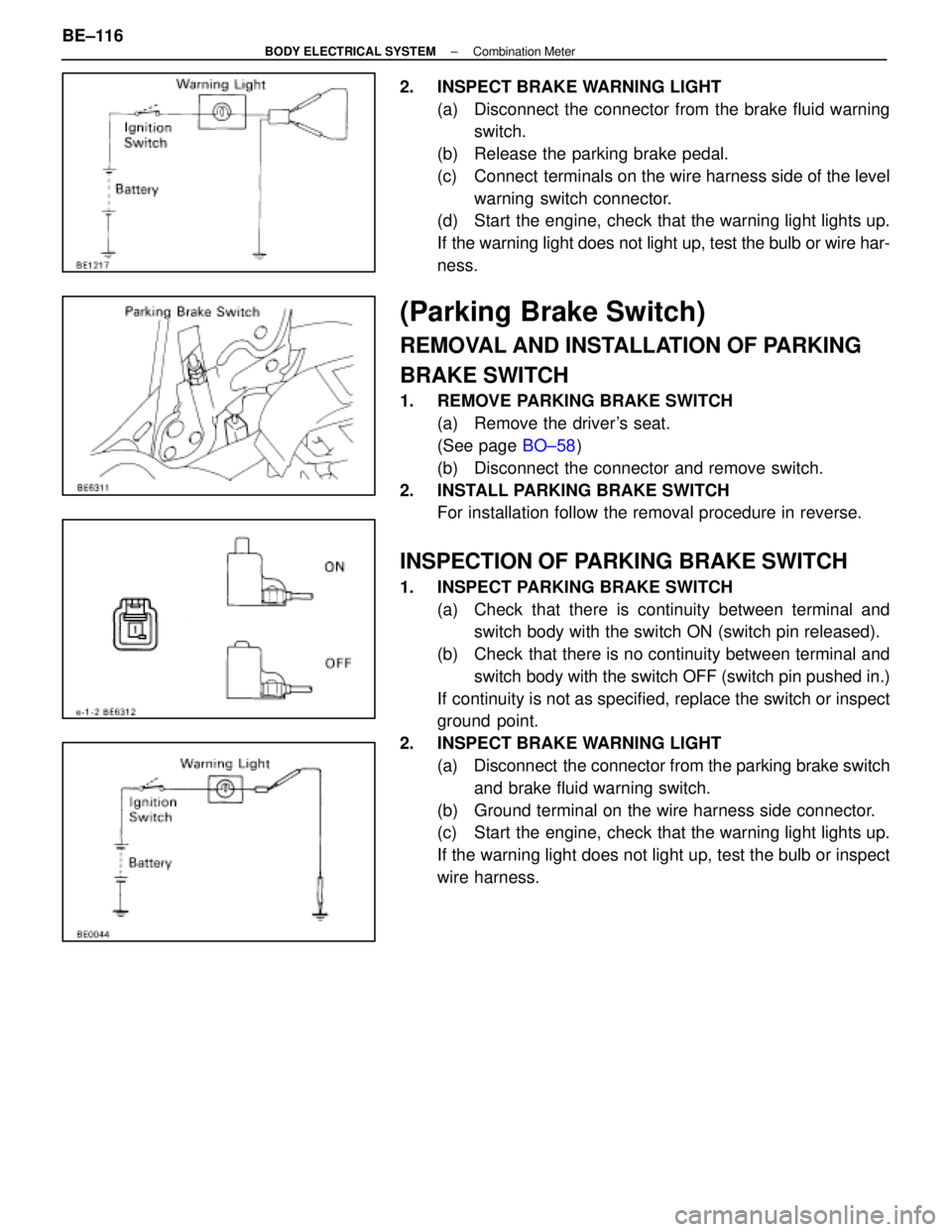Page 285 of 4087
5. P POSITION TESTStop the vehicle on a gradient (more than 5 �) and after shift-
ing into the P position, release the parking brake. Then check
to see that the parking lock pawl holds the vehicle in place.
AT±44
±
A304E (1UZ±FE) AUTOMATIC TRANSMISSION TROUBLESHOOTING
WhereEverybodyKnowsYourName
Page 288 of 4087

AT00S±01
PRELIMINARY CHECK
1. CHECK FLUID LEVELHINT:
wDrive the vehicle so that the engine and transmission
are at normal operating temperature.
Fluid temp.: 70±80 5C (158±176 5F)
w Only use the COOL range on the dipstick as a rough
reference when the fluid is replaced or the engine does
not run.
(a) Park the vehicle on a level surface and set the parking brake.
(b) With the engine idling and the brake pedal depressed, shift the shift lever into all positions from P to L position and return
to P position.
(c) Pull out the transmission dipstick and wipe it clean.
(d) Push it back fully into the tube.
(e) Pull it out and check that the fluid level is in the HOT range. If the level is at the low side, add fluid.
Fluid type:
ATF TYPE T±II or Equivalent
NOTICE: Do not overfill.
2. CHECK FLUID CONDITION If the fluid smells burnt or is black, replace it.
3. REPLACE TRANSMISSION FLUID
(a) Remove the drain plug and drain the fluid.
(b) Reinstall the drain plug securely.
(c) With the engine OFF, add new fluid through the oil filler tube.
Fluid type:
ATF TYPE T±II or Equivalent
Capacity:
Total: 8.2 liters (8.7 US qts, 7.2 lmp. qts)
Drain and refill: 1.9 liters (2.0 US qts, 1.7 lmp. qts)
(d) Start the engine and shift the shift lever into all positions fromP to L position and then shift into P position.
(e) With the engine idling, check the fluid level. Add fluid up to the
COOL level on the dipstick.
±
A304E (1UZ±FE) AUTOMATIC TRANSMISSION TROUBLESHOOTINGAT±47
WhereEverybodyKnowsYourName
Page 291 of 4087

MECHANICAL SYSTEM TESTS
AT0QT±01
STALL TESTThe object of this test is to check the overall performance of the trans\
mission and engine by measuring
the stall speeds in the D and R positions.
NOTICE:
� Perform the test at normal operating fluid temperature 50±80 �C (122±176 �F).
� Do not continuously run this test longer than 5 seconds.
� To ensure safety, conduct this test in a wide, clear, level area, which provides good traction.
� The stall test should always be carried out in pairs. One technician sho\
uld observe the conditions of
wheels or wheel stoppers outside the vehicle while the other is performi\
ng the test.
MEASURE STALL SPEED
(a) Chock the 4 wheels.
(b) Connect a tachometer to the engine.
(c) Fully apply the parking brake.
(d) Keep your left foot pressed firmly on the brake pedal.
(e) Start the engine.
(f) Shift into the D position. Step all the way down on the accelerator peda\
l with your right foot.
Quickly read the stall speed at this time.
Stall speed:
2,200 + 150 RPM
(g) Perform the same test in R position.
AT±50±
A304E (1UZ±FE) AUTOMATIC TRANSMISSION TROUBLESHOOTING
WhereEverybodyKnowsYourName
Page 293 of 4087
TIME LAG TEST
When the shift lever is shifted while the engine is idling, there will be a \
certain time lapse or lag before the
shock can be felt. This is used for checking the condition of the O/D direct \
clutch, forward clutch, direct
clutch, and first and reverse brake.
NOTICE:
�Perform the test at normal operating fluid temperature 50±80 �C (122±176 �F).
� Be sure to allow a one minute interval between tests.
� Make 3 measurements and take the average value.
MEASURE TIME LAG
(a) Fully apply the parking brake
(b) Start the engine and check idle speed.
Idle speed:
650 RPM (In N position and air conditioner OFF)
(c) Shift the shift lever from N to D position. Using a stop watch, measure the time it take\
s from shifting thelever until the shock is felt.
In same manner, measure the time lag for N �R.
Time lag:
N D Less than 1.2 seconds
N R Less than 1.5 seconds
AT±52±
A304E (1UZ±FE) AUTOMATIC TRANSMISSION TROUBLESHOOTING
WhereEverybodyKnowsYourName
Page 295 of 4087

MEASURE LINE PRESSURE
NOTICE:
�Perform the test at normal operating fluid temperature 50±80 �C (122±176 �F).
� The line pressure test should always be carried out in pairs. One technicia\
n should observe the
conditions of wheels or wheel stoppers outside the vehicle while the other is perf\
orming the test.
� Be careful to prevent the oil pressure gauge hose from interfering with \
the exhaust pipe.
(a) Warm up the transmission fluid.
(b) Remove the test plug on the transmission case left side and connect the \
oil pressure gauge SST.
SST 09992±00094
HINT: Connecting the oil pressure gauge will be made easier by moving LH sid\
e heat insulator aside.
(c) Fully apply the parking brake and chock the 4 wheels.
(d) Start the engine and check idling RPM.
(e) Keep your left foot pressed firmly on the brake pedal and shift into D p\
osition.
(f) Measure the line pressure when the engine is idling.
(g) Press the accelerator pedal all the way down. Quickly read the highest line pressure when engine speedreaches stall speed.
(h) In the same manner, perform the test in R position. AT±54
±
A304E (1UZ±FE) AUTOMATIC TRANSMISSION TROUBLESHOOTING
WhereEverybodyKnowsYourName
Page 298 of 4087
(f) Fully apply the parking brake and chock the 4 wheels.
(g) Start the engine and check idling RPM.
(h) Keep your left foot pressed firmly on the brake pedal and shift into D p\
osition.
(i) Measure the accumulator back pressure.
(j) With the conditions the same as in (h), ground the other probe of the test\
lead which has one end insertedinto the terminal SLN of the ECM harness side connector, then measure the accumulator back pressure
again.
±
A304E (1UZ±FE) AUTOMATIC TRANSMISSION TROUBLESHOOTINGAT±57
WhereEverybodyKnowsYourName
Page 537 of 4087

2. INSPECT BRAKE WARNING LIGHT(a) Disconnect the connector from the brake fluid warningswitch.
(b) Release the parking brake pedal.
(c) Connect terminals on the wire harness side of the level warning switch connector.
(d) Start the engine, check that the warning light lights up.
If the warning light does not light up, test the bulb or wire har-
ness.
(Parking Brake Switch)
REMOVAL AND INSTALLATION OF PARKING
BRAKE SWITCH
1. REMOVE PARKING BRAKE SWITCH
(a) Remove the driver's seat.
(See page BO±58)
(b) Disconnect the connector and remove switch.
2. INSTALL PARKING BRAKE SWITCH For installation follow the removal procedure in reverse.
INSPECTION OF PARKING BRAKE SWITCH
1. INSPECT PARKING BRAKE SWITCH
(a) Check that there is continuity between terminal andswitch body with the switch ON (switch pin released).
(b) Check that there is no continuity between terminal and switch body with the switch OFF (switch pin pushed in.)
If continuity is not as specified, replace the switch or inspect
ground point.
2. INSPECT BRAKE WARNING LIGHT (a) Disconnect the connector from the parking brake switchand brake fluid warning switch.
(b) Ground terminal on the wire harness side connector.
(c) Start the engine, check that the warning light lights up.
If the warning light does not light up, test the bulb or inspect
wire harness.
BE±116
±
BODY ELECTRICAL SYSTEM Combination Meter
WhereEverybodyKnowsYourName
Page 825 of 4087

(HEADLIGHT SYSTEM)
Description ± Headlight System
The component parts of this system and their function are described in the \
following table.
Parts NameFunction
Light Control SwitchGrounds current from the headlight control relay and taillight control r\
elay via the
integration relay, switching each relay and supplying current to the appropriate bulbs
accordance with the switch position.
Dimmer SwitchGrounds current from the dimmer relay in accordance with the switch posi\
tion, turning
on the ºLO±Beamº or ºHI Beamº lights. In the case of º\
FLASHº it turns the heading
control relay and turns on the ºHI Beamº lights.
Headlight Control
RelayTurned on by signals from the light control switch, dimmer switch and run\
ning light
relay and supplies current to each bulb or headlight dimmer relay.
Headlight
Dimmer RelayReceives current from the headlight control relay, which switches the relay according
to the position of the dimmer switch and sends current to the headlight \
ºLO±Beamº
or ºHI Beamº.
Integration RelayCarries out ºLight Auto Turn±offº of the headlights and taillights and cuts off current to
the light control switch in accordance with signals from the GAUGE fuse \
and courtesy
switch.
Door Courtesy
Switch/Driver 'sDetects when the door is open and sends the appropriate signals to integ\
ration relay.
(Light Auto Turn±Off System)
Parking Brake
Switch
(CANADA)Detects when the parking brake lever is released and sends the appropria\
te signals to
daytime running light relay.
±
BODY ELECTRICAL SYSTEM Lighting SystemBE±29
WhereEverybodyKnowsYourName